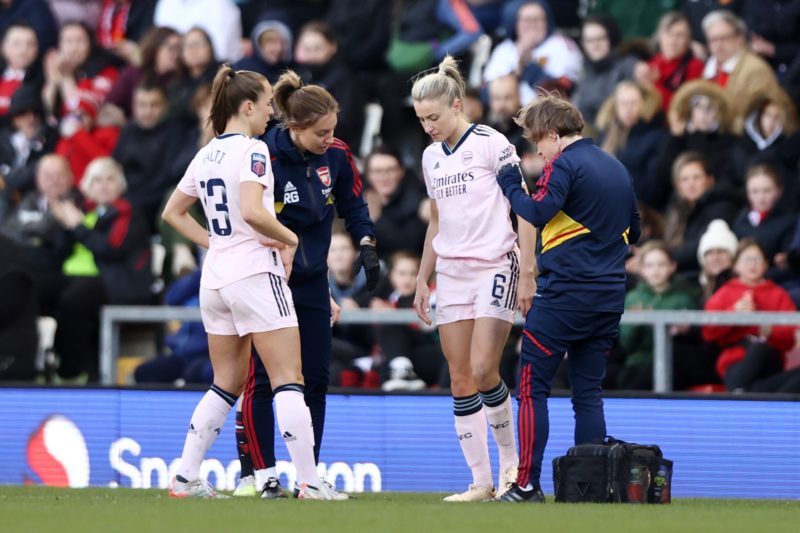Leah Williamson suffers a ruptured ACL during a Women’s Super League match against Manchester United, facing an extended recovery.

- Leah Williamson suffers a ruptured ACL during Arsenal’s Women’s Super League match against Manchester United.
- The Arsenal defender faces an extended period on the sidelines and will undergo surgery to repair the ligament.
- Williamson’s injury is a significant blow for Arsenal’s season, where her leadership and defensive skills will be deeply missed.
Arsenal’s Women’s Super League campaign suffered a major blow as Leah Williamson sustained a ruptured anterior cruciate ligament (ACL) during the match against Manchester United on Wednesday night.
The defender was forced to leave the field in the first half at Leigh Sports Village, with further assessment on Thursday confirming the severity of the injury.
Devastating injury for Leah Williamson
Williamson will now undergo a period of rehabilitation and face an extended spell on the sidelines.
The 25-year-old will require surgery to repair the damaged ligament, with an exact timeline for her return still uncertain.
As ACL injuries typically take several months to fully recover, it is likely that Williamson will miss the start of next season.
Support and rehabilitation at Arsenal
Arsenal have expressed their full support for Leah during her recovery, stating, “Everyone at Arsenal will be supporting Leah closely throughout the journey ahead.”
The club has also requested that her privacy be respected during this challenging time.
Williamson will work closely with the team’s medical staff and physiotherapists to ensure she makes a strong and safe return to the pitch.
Implications for Arsenal’s season
The loss of Williamson is a significant setback for Arsenal, as her leadership and defensive prowess have been vital to the team’s success.
Her absence will undoubtedly be felt on the field, and it will be up to her teammates to rise to the occasion and fill the void left by the injured star.
Arsenal will likely need to explore other defensive options and make adjustments to their strategy in the coming weeks.
This is the third Arsenal player to pick up this injury with Beth Mead and Vivianne Miedema also suffering the same problem.
All three will miss this summer’s World Cup.
What is an ACL ligament injury?
An anterior cruciate ligament (ACL) injury is a common sports-related injury that affects the knee joint.
The ACL is one of the four main ligaments in the knee, providing stability and preventing excessive forward movement of the tibia (shinbone) relative to the femur (thighbone).
ACL injuries can range from mild sprains to complete tears and are often caused by sudden changes in direction, abrupt stops, or forceful impacts to the knee.
Symptoms of an ACL injury may include:
- A loud “pop” or feeling of tearing in the knee during the injury.
- Swelling in the knee, typically within a few hours of the injury.
- Pain, particularly when trying to put weight on the affected leg.
- Reduced range of motion in the knee.
- Instability, with the knee giving out or feeling as if it will buckle under the person’s weight.
Diagnosis of an ACL injury typically involves a physical examination by a healthcare professional, who may assess the knee’s range of motion, stability, and swelling.
Imaging techniques such as X-rays, magnetic resonance imaging (MRI), or ultrasound may be used to confirm the diagnosis and assess the severity of the injury.
Treatment for an ACL injury depends on the severity of the injury and the individual’s needs. Conservative treatment, including rest, ice, compression, and elevation (RICE) and physical therapy, may be sufficient for mild sprains.
In more severe cases, or when the individual is an athlete who wants to return to their sport, surgical reconstruction of the ACL may be recommended.
This surgery typically involves using a graft from another tendon in the body or a donor tendon to replace the damaged ligament.
Rehabilitation and physical therapy are crucial for a successful recovery, regardless of whether the treatment is conservative or surgical.
The therapy program focuses on restoring strength, flexibility, and stability in the knee, with the ultimate goal of returning to normal activities and sports.
Recovery time can range from several months to a year, depending on the severity of the injury and the individual’s adherence to the rehabilitation program.

